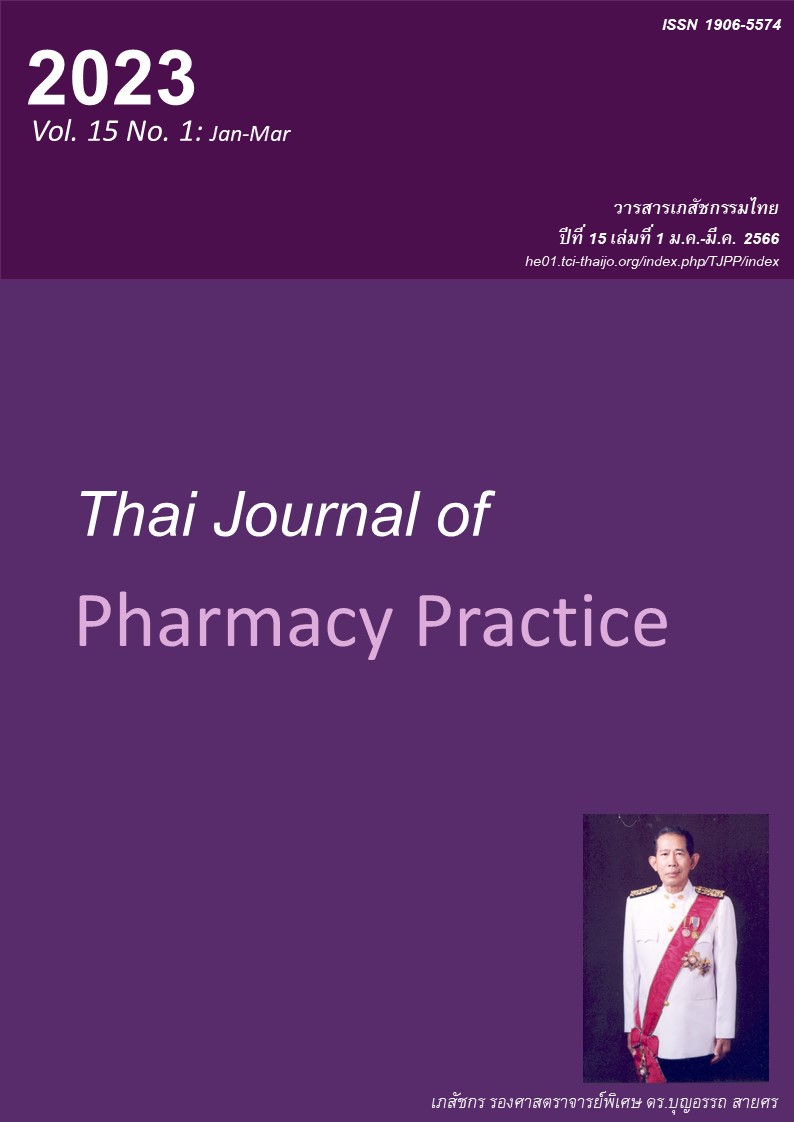การวิเคราะห์รูปแบบการใช้ยาสมุนไพรในผู้ป่วยนอกของหน่วยบริการสาธารณสุข ในจังหวัดสมุทรสงครามด้วยระบบธุรกิจอัจฉริยะ
Main Article Content
บทคัดย่อ
วัตถุประสงค์: เพื่อวิเคราะห์รูปแบบการใช้ยาสมุนไพรในงานผู้ป่วยนอกของหน่วยบริการสาธารณสุขจังหวัดสมุทรสงครามด้วยระบบธุรกิจอัจฉริยะ และเสนอแนวทางในการส่งเสริมการใช้ยาสมุนไพร วิธีการ:งานวิจัยนี้เป็นงานวิจัยเชิงพรรณนาเพื่อการวิเคราะห์รูปแบบการใช้ยาสมุนไพรจากแฟ้มข้อมูลตามโครงสร้างมาตรฐานข้อมูลด้านสุขภาพกระทรวงสาธารณสุข (43 แฟ้ม) ของหน่วยบริการสาธารณสุขจังหวัดสมุทรสงครามในปีงบประมาณ 2563 ด้วยระบบธุรกิจอัจฉริยะ Microsoft Power BI Desktop ผลการวิจัย: การใช้ยาสมุนไพรในงานผู้ป่วยนอกในจังหวัดสมุทรสงครามเป็นการใช้ในหน่วยบริการระดับปฐมภูมิร้อยละ 74.20 และโรงพยาบาลร้อยละ 25.80 ผู้สั่งใช้สูงสุด ได้แก่ พยาบาลวิชาชีพ นักวิชาการสาธารณสุข เจ้าพนักงานสาธารณสุขชุมชน แพทย์ และแพทย์แผนไทย ตามลำดับ กลุ่มวินิจฉัยโรคหลักตาม ICD10 ที่มีการสั่งใช้ยาสมุนไพรสูงสุด ได้แก่ โรคระบบหายใจ อาการที่วินิจฉัยไม่ได้ โรคทางการแพทย์แผนไทย โรคหัวใจและหลอดเลือด โรคต่อมไร้ท่อ โรคกระดูกและกล้ามเนื้อ และโรคระบบทางเดินอาหาร ตามลำดับ มีการใช้ยาสมุนไพรทั้งหมด 38 รายการ โดยยาที่มีการใช้สูงสุด ได้แก่ ฟ้าทะลายโจร มะแว้ง มะขามป้อม ขมิ้นชัน และมะขามแขก ตามลำดับ ยาที่มีต้นทุน/ครั้งต่ำสุดคือ มะแว้ง ฟ้าทะลายโจร และเถาวัลย์เปรียง ยาแผนปัจจุบันที่สามารถใช้ยาสมุนไพรทดแทนได้ตามประกาศกรมการแพทย์แผนไทยที่มีการใช้สูงสุดตามลำดับคือ dimenhydrinate, paracetamol+orphenadrine, analgesic balm, paracetamol และchlorpheniramine แนวทางการเพิ่มการใช้ยาสมุนไพร ได้แก่ การส่งเสริมการใช้ยาสมุนไพรทดแทนยาแผนปัจจุบันรายการที่มีปริมาณการใช้สูง การส่งเสริมการใช้ยาสมุนไพรต้นทุน/ครั้งต่ำ และการส่งเสริมการสั่งใช้ยาสมุนไพรของแพทย์ในโรงพยาบาล สรุป: การใช้ยาสมุนไพรส่วนใหญ่เป็นการใช้โดยบุคลากรในหน่วยบริการระดับปฐมภูมิ ทั้งการใช้ตามอาการและตามการวินิจฉัยโรค ผู้เกี่ยวข้องควรส่งเสริมการใช้ยาสมุนไพรที่มีต้นทุน/ครั้งต่ำ และทดแทนยาแผนปัจจุบันที่มีการใช้สูง โดยเฉพาะในการสั่งใช้ยาของแพทย์ในโรงพยาบาล การวิเคราะห์ข้อมูลการใช้ยาสมุนไพรขนาดใหญ่ด้วยระบบธุรกิจอัจฉริยะ ทำให้เห็นข้อมูลการใช้ยาสมุนไพรได้หลากหลายมุมมอง ซึ่งสามารถนำไปใช้ในการวางแผนเพื่อเพิ่มการใช้ยาสมุนไพรได้
Article Details

อนุญาตภายใต้เงื่อนไข Creative Commons Attribution-NonCommercial-NoDerivatives 4.0 International License.
ผลการวิจัยและความคิดเห็นที่ปรากฏในบทความถือเป็นความคิดเห็นและอยู่ในความรับผิดชอบของผู้นิพนธ์ มิใช่ความเห็นหรือความรับผิดชอบของกองบรรณาธิการ หรือคณะเภสัชศาสตร์ มหาวิทยาลัยสงขลานครินทร์ ทั้งนี้ไม่รวมความผิดพลาดอันเกิดจากการพิมพ์ บทความที่ได้รับการเผยแพร่โดยวารสารเภสัชกรรมไทยถือเป็นสิทธิ์ของวารสารฯ
เอกสารอ้างอิง
Ritthiraksa S, Chanket R, Sangsakda M, Kitthavee S, Sornrung W. Policy to support the use of herbal medicines in service units under the Ministry of Public Health. Journal of Thai traditional and alternative medicine 2018; 16: 145-57.
Department of Thai Traditional and Alternative Medicine. List of herbal medicines that can be used instead of modern medicine, 31 items [online]. 2019 [cited Jan 1, 2022]. Available from: www.dtam.moph .go.th/index.php/th/download/4256-dl0055.html.
Thai Traditional Pharmacy Academic Working Group, Institute of Thai Traditional Medicine. Information on traditional Thai medicines and herbal medicines that can be used instead of modern medicines: Medicines on the National Essential Medicines List [online]. 2016 [cited Jan 1, 2022]. Available from: www.dtam.moph.go.th/images/download/dl0055-21 22561_2.pdf.
Samut Songkhram Provincial Public Health Office. HDC v4.0 [online]. 2014 [cited Jan 1, 2021]; Availa- ble from: skm.hdc.moph.go.th/hdc/main/index.php.
Harinwan P, Damnoensawat W, Srikrachang P, Maneewong N. Usage of herbal alternative to modern medicine in Lamphang hospital and commuity hospitals in Lampanag Provice 2002-2006. Journal of Health System Research 2009; 3: 412-18.
Nonting P, Charoenporn S, Kunwaradisai N, Watcha rathanakij S, Vadhnapijyakul A. Situation restrictions for the use of herbal medicines in public hospitals. Isan Journal of Pharmaceutical Sciences 2013; 9: 9-29.
Meechumnarn T. Evaluation of the use of herbal and Thai traditional medicines in hospitals under the Ministy of Public Health in Roi-et Province in 2014. Thai Journal of Pharmacy Practice 2015; 7: 155-66.
Meksawatdichai Ch, Evaluation of policies promoting the use of herbal medicine in hospitals in the Ministry of Public Health in Saraburi Province in 2017. Journal of Thai Traditional and Alternative Medicine 2017; 17: 516-26.
Strategy and Planning Division, Office of the Perma nent Secretary. Operating manual Storing and trans mitting information in accordance with the health information standards structure, Ministry of Public Health Version 2.4 in fiscal year 2021. Nonthaburi: Ministry of Public Health; 2021.
Nakprach S, Jamarik K. Disclosure of government data in the form of Business Intelligence (BI) in the big data era. NBTC Journal 2016: 553-8.
Tanguthairueang T. Visual data analysis with Power BI. Bangkok: Suan Dusit University; 2021.
Mona I.M, Adegboyega O, Francis J.S. Analysis of business intelligence applications in healthcare organizations. In: Bui T, editor, Proceeding of the 52nd Hawaii International Conference on System Sciences; 2019 Jan 8-11; Grand Wailea, Maui, Hawaii, USA; 2019. p. 4155-64.
Puangrat j, Mullica J, Krisanadej J. Business intelli gence and its applications in the public healthcare system. Walailak J Sci Tech 2011; 8: 97-100.
Saeed R, Sara A. Review Study: Business intelli gence concepts and approaches. Am J Sci Res 2012; 50: 62-75.
Thananat K. Information system for hospital quality, improvement using business intelligence (BI) tool. Case studies: Queen Savang Vadnana Memorial Hospital [master thesis]. Chonburi: Burapha Univer- sity; 2016.
Patthama T. Business Intelligence system to support executive forecasting and deision making case study: Healthcare [master thesis]. Bangkok: Sripa- tum University; 2018.
Srattnaphut L. Managing health data and interactive analytical reports with MS Excel. Nakhon Pathom: Silpakorn University; 2017.
National Health Security Office. Guidelines for claiming expenses for health services, fiscal year 2020. Bangkok: National Health Security Office; 2019.
Bureau of Policy and Strategy, Office of the Perma nent Secretary. International statistical classification of diseases, Thai edition. Nontaburi: Ministry of Public Health; 2012.
Department of Thai Traditional and Alternative Medi- cine. Thai traditional medicine list for hospitals and public health service units 2010 [online]. [cited Dec 1, 2021] Avilable form: www.dtam.moph.go.th/image s/document/thai-med/thaimedcine_BE255307-10-54 .pdf.
Strategy and Planning Division, Office of the Perma nent Secretary, Ministry of Public Health. Details of the indicators of the Ministry of Public Health Annual Budget B.E. 2022 [online]. 2021 [cited Dec 1, 2021] Avilable form: phdb.moph.go.th/main/upload/web_ne ws_files/95o0rrqbu6scks4go4.pdf.
Sanalad R, Kittiboonyalkhun P, Nualkaew S. Effects of the intervention for promoting the prescribing of herbal medicines in the National Lists of Essential Medicines in community hospitals at Mahasarakham Province. Thai Journal of Pharmacy Practice 2021; 13: 934-42.
Wattanapichayakul A, Suthiphan N. Policy to promote Thai traditional medicine in government hospitals: myth or reality. Isan Journal of Pharma- ceutical Sciences 2014; 9: 149-54.
Tosanguan K. View of health professionals on herbal medicine and policy for promotion of herbal medicine use in healthcare settinng. Journal of Health Systems Research 2011; 5: 513-21.
Khaesuntia P, Kanjanarach T. Problems and sugge- stions for substituting modern medications with herbal medicines in public hospitals: A pilot study from the perspective of health professionals at community hospitals in the Northeast.Thai Journal of Pharmay Practice 2021; 13: 838-46.
Pratumchat T, Kessomboon P. Prescribing herbal medicine for patients by health care officers at tambon health promoting hospitals in Nong Bua Lam Phu Province. Community Health Development Quarterly Khon Kaen University 2015; 3: 96-110.
Jirawatkul A. Statistic for health science research. Bangkok. Wittayapat; 2018.


